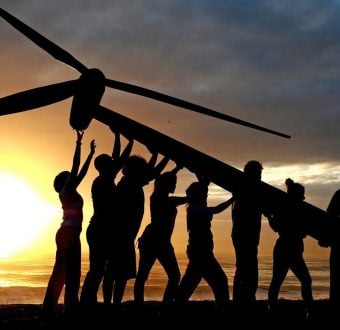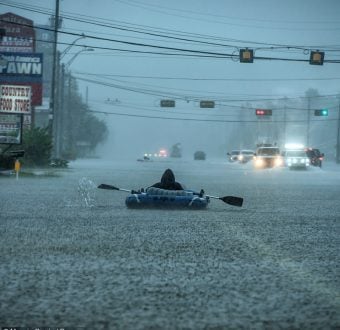The Greenpeace activists used speedboats to reach the 750 foot long Stena Carron drill ship. Having climbed up the giant rungs of the anchor chain, Victor Rask from Sweden and Anais Schneider from Germany are now hanging more than 16 feet above the waves in a tent suspended by ropes from one of the three foot long rungs, rendering the ship unable to move. Operated by US energy giant Chevron, the Stena Carron is due to sail for a site in the Lagavulin oil field where it plans to drill an exploratory well in more than 1600 feet of water.
Anais and Victor have just returned from a Greenpeace expedition to the Arctic, where they were members of the team that stopped drilling at a controversial deep water drilling rig operated by Edinburgh-based Cairn Energy.
Speaking this morning by satellite phone from the tent hanging from the Chevron anchor chain, 29 year old Anais said:
“It was incredible to climb up the anchor chain, the rungs were nearly as big as I am and Chevron’s drilling ship is one of the biggest things I’ve ever seen at sea. I’m in the tent now and we have supplies to last through to tomorrow at least, meaning we can stop it leaving to drill for oil in deep water. The Shetlands are so beautiful and an oil spill here could devastate this area and the North Sea. It’s time to go beyond oil. Our addiction is harming the climate, the natural world and our chances of building a clean energy future.”
In the Gulf of Mexico, the Greenpeace ship Arctic Sunrise continues a three-month research expedition with an independent research team on board led by marine scientist and oceanographer Dr. Rainer Amon studying the extent, composition and impacts of the oil and gas that has entered the Gulf’s deep water following the oil spill. Following the report released in early August by the National Incident Command that revealed that between three and four million barrels of oil remain in the Gulf environment, this research will make an important contribution to increasing our understanding of the environmental aftermath of the spill. The work will include documenting the status of the chemical and biological aspects of the Gulf’s waters, in order to assess the impact of the oil spill on the gulf ecosystems, gauging dissolved oxygen levels as a tool to locate areas affected by the oil and gas.
The Arctic Sunrise is performing transects of the Gulf in an area to the west of the Deepwater Horizon site, south of Texas and Louisiana, collecting water samples from depths of up to two kilometers. The ship will also spend time close to the disaster site, where the science team plans to take sediment samples, to find out how much oil has reached the sea floor.
###
To reach the Arctic Sunrise and the researchers on board, contact Dave Walsh, Media Officer, Greenpeace, +31 20 712 2616 [email protected] or Molly Dorozenski, 917-864-3724
For more information about efforts to challenge Chevron’s Shetlands Islands drilling project, contact Szabina Mozes, Greenpeace International Communication on +31 646 16 2023
For video and stills contact Melissa Thompson, Greenpeace International Video Desk: + 31 621 296899; John Novis, Greenpeace International Picture Desk: +44 (0) 7801 615 889

